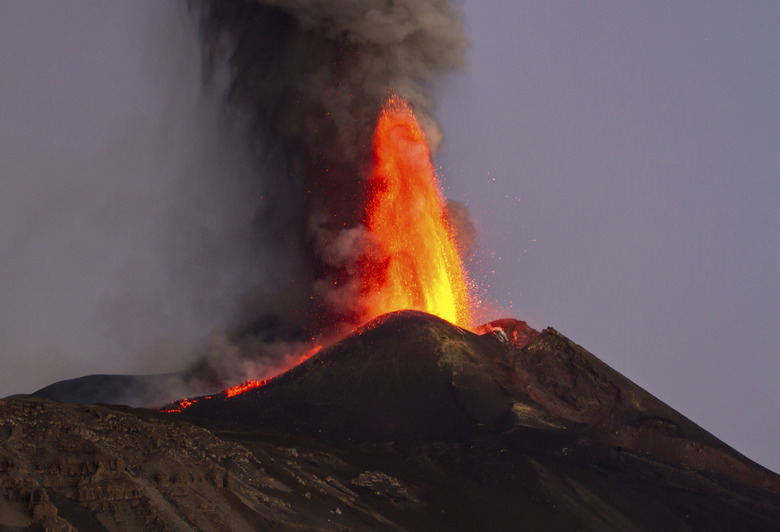How Does A Volcano Erupt?
A volcano marks a vent where magma, or molten rock, reaches the Earth's surface in the form of lava and associated materials. While many people envision a conical peak when they think of a volcano, a wide variety of landforms fall into the category, including midocean ridges and the fissures that erupt great sheets of flood basalts. Volcanic eruptions may be rather quiet and slow-paced, or they may be dramatically violent and catastrophic. Either way, they're a testament to the surging unrest of the inner Earth.
Sources of Volcanoes
Sources of Volcanoes
Volcanoes are typically found in two major sites on the planet: at the boundaries of tectonic plates and at so-called "hotspots," where magma rises from much more discrete heat sources in the mantle. Divergent plate boundaries are rifts where upwelling lava forms fresh oceanic crust at submarine volcanoes. Where one plate collides with another and shoves beneath it — a process called "subduction" — the diving plate melts at a certain depth to fuel belts of volcanoes. Hotspots are not entirely understood, but they appear to be responsible for some of the planet's most impressive landforms, such as the Hawaiian shield volcanoes and the massive Yellowstone supervolcano.
Eruption Basics
Eruption Basics
The eruptive behavior of a given volcano largely depends on the gas and mineral content of the magma that feeds it. Gases, called volatiles, include water vapor as well as carbon dioxide, sulfur dioxide and other elements. These volatiles are pressurized at depth and expand as the magma nears or attains the surface. How easily gases can escape the magma depends greatly on the substance's share of silica: A silica-rich magma is more viscous — that is, it flows less easily — and impedes gas release more significantly than a low-silica, more fluid magma. Thus magmas heavy in silica are more prone to explosive eruptions as pent-up gases build up intense pressure. The relative amount of silica in lava helps classify it: Basaltic lava is low in silica; andesitic lava, intermediate; and dacitic and rhyolitic lavas are rich in silica. These categories can explain eruptive behavior and also describe the rock types ultimately formed from hardened lava — geological formations hinting at past volcanic activity.
Eruption Phenomena
Eruption Phenomena
A volcanic eruption may emit lava flows, gases and pyroclastics, which are the debris of lava or crustal rock shattered in the explosion. Pyroclastic material, also called tephra, ranges from huge blocks and bombs to pulverized cinders and ash. Among the most destructive events associated with explosive eruptions are pyroclastic flows and surges, sometimes called "nuée ardente" — French for "glowing cloud." Pyroclastic flows are fast-moving curtains of searing gas and rock that sweep down the shoulders of volcano. Along their margins, they may kick up billows of gas-flared ash — pyroclastic surges — which, unlike the flows, can clear topographical barriers and travel impressive distances. Also formidable are lahars, water-saturated flows of debris — unleashed, for example, by rapidly melting summit glaciers — that can race down river valleys draining volcanoes.
Types of Explosive Eruptions
Types of Explosive Eruptions
A common categorization scheme for explosive eruptions names each type after specific volcanoes that exemplify it. Hawaiian eruptions are usually quiet flows of basaltic lava. Strombolian eruptions describe nearly continuous eruptions of gaseous lava at intermediate intensity, often characterized by small blasts tossing lava clods into the air. Vulcanian eruptions are more explosive yet: Gases accumulate beneath crust built by viscous lava, ultimately bursting forth to spew pumice and a great cloud of ash. Peléan eruptions feature explosive releases of energy after the collapse of a lava dome; the defining products are pyroclastic flows and surges. Those scorching avalanches also characterize Plinian eruptions, exceptionally powerful events that produce titanic ash clouds and sometimes the collapsed craters called calderas.
References
- U.S. Geological Survey: Plate-Tectonics Theory
- Fire Mountains of the West: The Cascade and Mono Lake Volcanoes; Stephen L. Harris
- How Volcanoes Work: Physicochemical Controls on Eruption Style
- Volcanoes of the Earth; Fred M. Bullard
- Global Volcanism Program: Types and Processes Gallery — Pyroclastic Flows
- U.S. Geological Survey: Types of Volcanic Eruptions
Cite This Article
MLA
Shaw, Ethan. "How Does A Volcano Erupt?" sciencing.com, https://www.sciencing.com/volcano-erupt-4620070/. 24 April 2017.
APA
Shaw, Ethan. (2017, April 24). How Does A Volcano Erupt?. sciencing.com. Retrieved from https://www.sciencing.com/volcano-erupt-4620070/
Chicago
Shaw, Ethan. How Does A Volcano Erupt? last modified March 24, 2022. https://www.sciencing.com/volcano-erupt-4620070/
